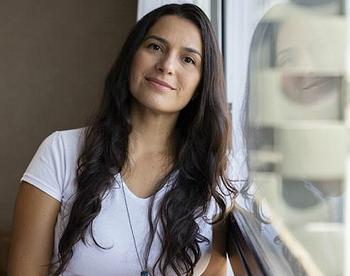
SAO PAULO, Brazil, February 10, 2021 (ENS) – Amid the isolation imposed by COVID-19, the brain resorts to dreams in an effort to metabolize the intense emotions experienced during the day and assimilate experiences that favor survival as we strive to adapt to the “new normal.”
Suddenly, we have to avoid kissing, hugging, and even friendly handshaking. Face coverings are mandatory when we leave the home, and we have to remove our shoes when we return. Hands and everything else must be sanitized and disinfected. More time must be devoted to children while we avoid friends and fellow workers. Bedrooms have become home offices and living room gyms. That old blue rug is a stand-in for the seaside.

“According to some theoreticians, dreams, in the context of deep-seated fear, are a sort of virtual superreality that lets us train and improve our performance in key aspects of our daily lives,” said Dr. Natalia Mota, a neuroscientist and postdoctoral researcher at the Federal University of Rio Grande do Norte’s Brain Institute in Brazil, told the São Paulo Research Foundation, Agência FAPESP.
Mota set out to test this hypothesis by analyzing accounts of dreams supplied by volunteers with the aim of investigating the effects of the pandemic and social isolation on the unconscious. An article on the study has been published as a preprint, not yet peer-reviewed, on the medical website medRxiv.
The study finds that the more people suffered in the first month of social isolation, the more likely they were to mention terms associated with the idea of “cleanness” in their accounts of dreams.
The study was part of Mota’s postdoctoral research project that was supervised by Sidarta Ribeiro and Mauro Copelli, who are researchers at UFRN and the Federal University of Pernambuco, respectively. Both are coauthors of the article and affiliated with the Neuromathematics Research, Innovation and Dissemination Center, NeuroMat, at the University of Sao Paulo. Neuromat is one of the Research, Innovation and Dissemination Centers, RIDCs, funded by FAPESP.
Software Tools for Clinical Use
Mota has developed speech analysis software for use in diagnosing psychiatric diseases, especially schizophrenia, with results displaying significant accuracy. These tools have been adapted for use in cognitive assessment, mainly of children learning to read and write, Ribeiro explained.
“We’ve found that healthy subjects begin organizing their speech between the ages of five and eight and that this skill improves steadily until they reach adulthood,” he said. “However, in people with disorders such as schizophrenia, it deteriorates when they reach adolescence.”
Previous studies by the research group showed that dream narratives are the richest seam to mine for this type of analysis because they provide direct access to the unconscious.
“If I tell you how my day was yesterday, for example, it will be a chronological narrative based on real facts. It will not be very different from the account offered by a bipolar or schizophrenic patient. However, when we compare dream narratives, we find they are all completely different,” Ribeiro said.
In his view, this is because dream narratives are not woven from interactions with other people, and pathological behavior is not diluted by the normality of the others involved in the story. “Dream narratives are free. They’re entirely constructed in the mind of the patient,” he said.
One of the computer programs developed by the group for clinical use collects data in the form of speech recordings sent from smartphones by the people who are to be assessed. The researchers validated the tool by asking healthy volunteers to send daily accounts of their dreams in messages lasting at least 30 seconds. This took place in September-November 2019.
“We were about to start testing a group of patients with schizophrenia when COVID-19 hit, which triggered a whole discussion about how the health crisis was changing the quality of sleep and dreams,” Mota said. “So, we decided to compare the samples we’d collected before the pandemic with the samples collected in the first month of the stay-at-home order, which were also collected from healthy volunteers, in order to investigate the differences in speech structure and content.”
Dream narratives sent in by 67 volunteers were analyzed using three tools developed by the group. The first focuses on structure by appraising the complexity and connectedness of each oral account submitted.
“Adults with a certain level of schooling and no mental illnesses tell coherent stories with a beginning, middle and end,” Mota said. “The discourse of a patient with schizophrenia tends to be relatively poor, fragmented and disorganized. This study involved healthy subjects, and as expected, we found no differences in terms of structure between the narratives sent before and after the pandemic.”
The other two software tools focus on content. One analyzes the content of a speech sample with a standard dictionary to measure the proportion of words or phrases referring to, for example, positive and negative feelings.
What Dreamers Experienced in Lockdown
“Generally, the dream narratives submitted during the pandemic have more content related to anger and sadness than those sent in before it began,” Mota said.
The third tool measures how closely the narratives correspond to certain themes or concerns by constructing semantic similarity maps. In this case, the researchers chose “contamination” and “cleanness”, “sickness” and “health” and “death” and “life” as themes.
“We found that dreams in the first month of lockdown were more associated with contamination and cleanness, but we didn’t observe any differences with regard to health/sickness or life/death,” Mota said.
“Our interpretation is that at the time, people were still adapting to the stricter rules governing hygiene and to the fear of contamination. Fear of death and sickness may not have appeared because none of the participants or close relatives had caught the disease up to that point.”

After a month, the researchers set out to measure the degree of mental suffering of all participants using standardized questionnaires called psychometric scales that are widely applied in mental health research.
“All volunteers displayed mild symptoms, but there was considerable variability,” Mota said. “When we correlated symptom severity with the specific themes, we found that volunteers with narratives containing more terms associated with cleanness expressed more difficulty in maintaining decent social relationships during the first month of the stay-at-home regime and were suffering more from this difficulty. This finding suggests poor adaptation to social isolation.”
After the end of the experiment, the researchers asked the volunteers to evaluate the experience of observing their own dreams during the 30-day period. The responses were divided into two groups depending on whether they were associated with positive feelings such as hope or negative feelings such as anxiety.
According to Mota, negative feelings were more frequent in the responses of subjects whose dreams correlated most with contamination and cleanness. “Generally, we concluded that observing dreams during the pandemic was a beneficial process,” she said. “It was a way of elaborating our emotions and thinking about our experiences. It can be helpful in a search for solutions.”
For Ribeiro, the study shows that dreams reflected the changes imposed by the pandemic quickly and robustly, confirming the continuity between dreams and waking life advocated by Sigmund Freud (1856-1939) and Carl Gustav Jung (1875-1961).
“The content of your dream life associated with this planetary emergency is expressed as suffering when you’re awake,” Ribeiro said. “This finding reinforces the idea proposed by Freud that dreams are the royal road to the unconscious and are particularly rich material for diagnosis.”
Mota says anyone who feels the urge to use her software can do so. “The name of the program is SpeechGraph and it was developed in Java language. It is available on our website, whoever wants to download and play with it, can download it,” she told AzMina magazine.
“ I ask people to tell me a dream or a negative image. Because in a dream report of only 30 seconds, the program is already able to tell quite accurately who has schizophrenia and who does not,” she explained
The study, “Dreaming during the COVID-19 pandemic: computational assessment of dreams reveals mental suffering and fear of contagion” is online<a href=”https://www.medrxiv.org/content/10.1101/2020.05.19.20107078v2″ target=”_blank”>here</a>.
— By Karina Toledo, Agência FAPESP
Copyright Environment News Service (ENS) 2021. All rights reserved.



